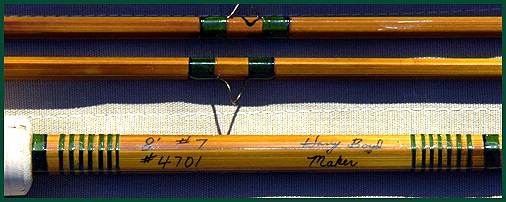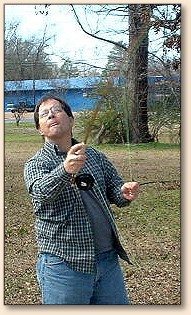|
I often wondered what the people who were recipients of
my father's crafts thought to themselves. How they felt,
what they perceived, where their thoughts found a quiet
corner to contemplate.
My father was a boat builder, jewelry maker, woodworker
and woodcarver, among many things. From a battered old shop
with a dirt floor in the backyard, magic flowed in a ceaseless
stream, most to be sold in the craft shop my grandparents
ran out of a room of this old house I live in now. I would
sit with him in that old shop, watch the boat or the watchband
or bolo tie come together, see it leave, but I could not
comprehend what the customer who might wander into the crafts
shop at my grandparents' might feel, think, see there.
Even in my later years when, sadly, after my father's death
I found the drive to build on my own was overwhelming, I
could not imagine what really lurked behind the praise for
a curly maple armoire, a bookshelf, a dresser of drawers.
Perhaps I am beginning to understand it, as I grow older, as
I perceive from my own quite corner at the side-edge of a life.
It was nearly a year ago that arrangements were made with
Harry Boyd for a rod. Harry is a bamboo rodmaker who hails
from Louisiana, so a Boyd Rod Co. model would be a natural
for me. I had only met Harry once, briefly, at a club conclave
in Lafayette, but we had corresponded by email many times.
I was thinking of a bass rod, something at eight feet, and
Harry suggested a seven weight based on the Dickerson Guide
Special taper, hollow built. He even suggested it would be
suitable for marsh redfish and speckled trout. Sounded like
a winner to me and so I agreed.
As most of you kind folks know, it was quite a busy year
for me: Two television programs on Fly Fishing America,
two hurricanes and all that. The time passed quickly with
all the excitement down here, and before I knew it, Harry
was telling me the rod was ready. He would have been happy
to mail it to me, but I insisted on driving to Winnsboro,
Louisiana to pick it up. On the one hand I couldn't bear
the thought of entrusting it to the mail, though rodmakers
do so all the time, but also, I felt like it was the right
thing to do, since Harry and I had only briefly had time
to talk face-to-face.
I had only been exposed to a few cane rods, but loved them
greatly. Of the bunch my favorite was a nine-foot Granger
Victory, pre-Wright and McGill takeover vintage. A
medium-action rod, the Victory was nonetheless my "go to"
rod for bass fishing around here.
The first trip was a bust due to bad weather, but the following
weekend a buddy of mine and I took to the road for the four-hour
trip to Winnsboro. Upon arriving, I had written down Harry's
directions to his house: Turn here. Then turn there. One driveway,
I counted aloud, second driveway...
"Maybe it's the one with that guy casting a fly rod in the
driveway," my pal said. Sure enough, there was Harry, and
there was an awful lot of line out in front on him as I
turned in. Quick introductions and Harry said, "This isn't
your rod. I decided to build one for myself, too," and then
ushered us inside where we met Harry's wife and, without a
lot of fanfare but a broad grin, Harry put a tube in my hand.
"Here's your rod," he said.
I used to wonder what people felt and thought and perceived
when they took delivery of one of my father's wooden bateaus
or calumets; one of my grandparents river cane baskets or one
of my piddlings in the woodshop. I used to guess at the emotions,
thoughts. Now I think I know.
As the top came off and the rod bag came out the tube, then the
butt and two tips of the rod emerged, I knew what it was like.
The burl reel seat insert, the fine, bright reel seat, green
wraps, black tipping, and oh, the cane. Glowing, it was, speaking,
too. He had inscribed "Native Waters" on one flat and I felt
myself flush with pride.

What I have long loved about antique firearms, handmade furniture,
bamboo rods, many such things was the mark of the craftsman. Men
like my father, like my grandfather, but they were always detached.
Distant. I didn't know the name or the face behind the Granger,
the old Damascus twist double-barrel that had been in the family
for generations, the Edison Amberola in the den. Certainly I knew
my father and grandfather and grandmother, but the detachment
was still there, somehow. From the inside, looking out I still
couldn't perceive the entirety of it.
 But as Harry led us back outside and I strung up the rod and before
I knew it, threw an awful lot of line out - more than I had ever
cast before with any rod - I saw from the corner of my eye Harry
beaming like a proud parent. Like the way my father would grin
widely when a boat left on a shiny galvanized trailer, or a violin
cradled in the crook of an arm, or a turquoise and silver band on
a wrist. I understood at last that the beauty of the craft is only
half the story: The other half is that it moved directly from the
maker's hand to the user's, the wearer's.
But as Harry led us back outside and I strung up the rod and before
I knew it, threw an awful lot of line out - more than I had ever
cast before with any rod - I saw from the corner of my eye Harry
beaming like a proud parent. Like the way my father would grin
widely when a boat left on a shiny galvanized trailer, or a violin
cradled in the crook of an arm, or a turquoise and silver band on
a wrist. I understood at last that the beauty of the craft is only
half the story: The other half is that it moved directly from the
maker's hand to the user's, the wearer's.
I think I said something like, "It's exquisite," but Harry will
have to tell you for sure, because I was in awe of the perfectly
balanced and extraordinarily powerful rod in my hand, conjuring
line behind and in front of me. I've never felt such wonder in
a fly rod, and sometimes when I'm casting it in the yard these
days, waiting for spring to actually get it out on the water,
I wonder if I ever will again.
"You weren't even using a haul," Harry observed, and I timidly
admitted I am terrible at the fabled double-haul, but with that
rod, I hardly needed it, even into the wind as I was casting.
We spent a couple hours with Harry in his rod making shop, a
tour which was nothing short of fascinating and added so much
more depth and perception to the rod in the tube that would be
going home with me. As the son and grandson of craftsmen, I
found myself within shops past and present, and the vision
of the craftsman huddled over his work, satisfied only with
the very best he could muster, unwilling to put his name on
anything else, ran as true in my memories as it did that day
standing there with Harry Boyd.
Then it was time to be off. Harry had a speaking engagement
and we had that four-hour ride back. We shook hands and Harry
said he wanted pictures of me and the first fish caught with
the rod. He said if I had any problems whatsoever with it
he'd take care of it. I thanked him again and pointed the
hood of the truck towards home.
I still haven't gotten it wet. The weather's just not
cooperating here, the water is high and muddy even when
temperatures are passable. But spring's just around the
corner, and Harry will get his picture. I take it out in
the yard often, and grow more enamored of it each time.
That's what it's all about, holding the work of a true
craftsman, who put it from his or her hand to yours, no
matter if it's a fly rod or something else. True craftsmen
let a little part of themselves go out with each piece.
The picture's coming Harry. It's going to be a great spring!
Boyd Rod Company can be reached at www.canerods.com.
~ Roger
|



 But as Harry led us back outside and I strung up the rod and before
I knew it, threw an awful lot of line out - more than I had ever
cast before with any rod - I saw from the corner of my eye Harry
beaming like a proud parent. Like the way my father would grin
widely when a boat left on a shiny galvanized trailer, or a violin
cradled in the crook of an arm, or a turquoise and silver band on
a wrist. I understood at last that the beauty of the craft is only
half the story: The other half is that it moved directly from the
maker's hand to the user's, the wearer's.
But as Harry led us back outside and I strung up the rod and before
I knew it, threw an awful lot of line out - more than I had ever
cast before with any rod - I saw from the corner of my eye Harry
beaming like a proud parent. Like the way my father would grin
widely when a boat left on a shiny galvanized trailer, or a violin
cradled in the crook of an arm, or a turquoise and silver band on
a wrist. I understood at last that the beauty of the craft is only
half the story: The other half is that it moved directly from the
maker's hand to the user's, the wearer's.